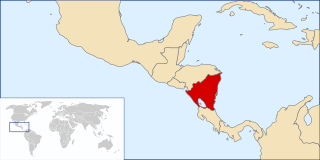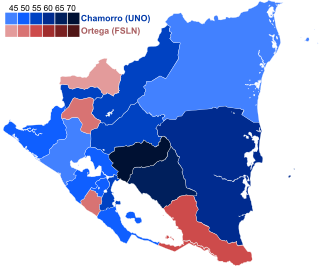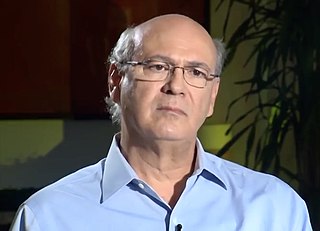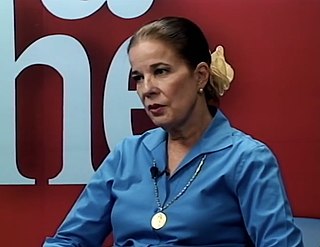The mass media in Nicaragua consist of several different types of communications media: television, radio, cinema, newspapers, magazines, and Internet-based Web sites. [1]
Freedom of speech is a right guaranteed by the Constitution of Nicaragua. There is no official state censorship of the media in Nicaragua. [2]
Noted during the Sandinista years for its virulently partisan and sensationalist character, the communications media began to show small signs of moderation and objectivity as the Chamorro regime progressed. [3] However, partisanship was still a key word in the printed and broadcast press, and Sandinista dominance over the communications media largely continued, despite the transfer of power in the government. [3] After the 1990 elections, however, important differences of opinion emerged in the relationship between the Sandinista-dominated media and official FSLN positions. [3]
The greatest news source for most Nicaraguans is the radio. [3] Some radio stations are considered so influential that opponents of their political position have targeted them for attacks. [3] The rightist Radio Corporación, for instance, was heavily damaged twice by Sandinistas, in the early years of the Chamorro government and the Sandinista Radio Ya was attacked by unknown assailants. [3]
The three major dailies of the Sandinista period continued to dominate the print media market in 1993. [3] La Prensa , founded in 1926, with an estimated circulation of 30,000 in early 1992, continued the family tradition built by the president's late husband, Pedro Joaquín Chamorro Cardenal. [3] At the time of the transition, La Prensa was run by the president's daughter, Cristiana Chamorro de Lacayo also the wife of Antonio Lacayo. [3] Cristiana Chamorro's tight control over La Prensa and reported refusal to permit criticism of her mother's government led to a rebellion among the editorial board and staff within a year after the 1990 election. [3]
The editorial staff, which included other family members, took the opportunity presented by Cristiana Chamorro's official trip abroad with her mother in November 1990, to publish articles harshly critical of the government for its relations with Sandinista leaders. [3] In January, the staff forced Cristiana Chamorro to resign as editor and removed Violeta Chamorro from the board of directors. [3] The changes were seen as an attempt by the editorial staff to establish La Prensa as an independent paper rather than the official voice of the government. [3]
One of the two pro-Sandinista newspapers also moved in the 1990s to a position more critical of the Chamorro government and the FSLN. [3] Barricada , founded in 1979, with an estimated circulation of 20,000 in 1992, declared in early 1992 that it would no longer serve as the house organ of the FSLN and would instead take independent positions. [3] Always regarded by many observers as the most professional of the three major newspapers, Barricada became the first public forum in which Sandinista leaders expressed internal disagreements in February 1992. [3]
The shift in popular outlook may have been made possible by the division of powers among the Sandinista commanders after their electoral defeat. [3] Bayardo Arce Castaño became head of the FSLN's newspapers, radio stations, and television programs and was planning to establish a Sandinista television station. [3] Significantly, the first disagreement aired in Barricada was between Arce and Daniel Ortega. [3]
The third main daily, El Nuevo Diario , which had an estimated circulation of 40,000 to 45,000 in 1992 and was founded in 1980 by Xavier Chamorro Cardenal, one of Violeta Chamorro's brothers-in-law, continued its loyal and uncritical posture of the FSLN, despite expectations that with the end of the Nicaraguan revolution the newspaper would take more independent positions. [3]
Several weekly newspapers also were published in the early 1990s. [3] The COSEP group brought out La Nicaragüense; a group headed by former vice president Sergio Ramírez published El Seminario in the early 1990s; and a Sandinista group continued Semana Cómica, a satirical tabloid. [3] A new weekly newspaper, El Centroamericano, also appeared in León in the early 1990s. [3]
Nicaraguan radio broadcasts in two bands:
Some stations are only talk radio — featuring interviews and discussions. Political parties also influence a majority of radio stations, some focusing on politics only.
The Internet has provided a means for newspapers and other media organizations to deliver news and, significantly, the means to look up old news. Some organizations only make limited amounts of their output available for free, and charge for access to the rest. Other organizations allow their archives to be freely browsed.

The Sandinista National Liberation Front is a Christian socialist political party in Nicaragua. Its members are called Sandinistas in both English and Spanish. The party is named after Augusto César Sandino, who led the Nicaraguan resistance against the United States occupation of Nicaragua in the 1930s.

Violeta Barrios Torres de Chamorro is a Nicaraguan former politician who served as the 55th President of Nicaragua from 1990 to 1997. She was the first and, to date, only woman to hold the position of president of Nicaragua. Previously, she was a member of the Junta of National Reconstruction from 1979 to 1980.
Pedro Joaquín Chamorro Cardenal was a Nicaraguan journalist and publisher. He was the editor of La Prensa, the only significant opposition newspaper to the long rule of the Somoza family. He is a 1977 laureate of the Maria Moors Cabot Prize of Columbia University in New York. He married Violeta Barrios de Chamorro, who later went on to become President of Nicaragua (1990–1997). In 1978, he was shot to death, one of the precipitating events of the overthrow of the Somoza regime the following year.
La Prensa is a Nicaraguan newspaper, with offices in the capital Managua. Its current daily circulation is placed at 42,000. Founded in 1926, in 1932 it was bought by Pedro Joaquín Chamorro Zelaya, who had become editor-in-chief. He promoted the Conservative Party of Nicaragua and became a voice of opposition to Juan Bautista Sacasa, for which the paper was censored. He continued to be critical of dictator Anastasio Somoza García, who came to power in a coup d'état.

Luis Alfonso Robelo Callejas, is a Nicaraguan businessman, was the founder of the Nicaraguan Democratic Movement (MDN).

The following is an alphabetical list of topics related to Nicaragua.

General elections were held in Nicaragua on 25 February 1990 to elect the President and the members of the National Assembly. The result was a victory for the National Opposition Union (UNO), whose presidential candidate Violeta Chamorro surprisingly defeated incumbent president Daniel Ortega of the Sandinista National Liberation Front (FSLN). This led to a historic peaceful and democratic transfer of power in Nicaragua.
Confidencial is a weekly newspaper in Nicaragua, with offices in the capital Managua. It was founded in 1996 by Carlos Fernando Chamorro Barrios. Chamorro is the former director of the Sandinista National Liberation Front newspaper Barricada and the son of Pedro Joaquín Chamorro Cardenal, Nicaraguan journalist and former editor of La Prensa whose murder in the last year of the rule of the Somoza family influenced public sympathy for the FSLN rebels.
In 1979, the Sandinista National Liberation Front (FSLN) overthrew Anastasio Somoza Debayle, ending the Somoza dynasty, and established a revolutionary government in Nicaragua. Following their seizure of power, the Sandinistas ruled the country first as part of a Junta of National Reconstruction. Following the resignation of centrist members from this Junta, the FSLN took exclusive power in March 1981.

Carlos Fernando Chamorro Barrios is a Nicaraguan independent investigative journalist. He is the founder and editor of Confidencial, a news website and weekly publication combining investigative journalism and analyses of current affairs. He also hosts two television news shows, Tonight and This Week. Chamorro is the youngest son of former president of Nicaragua Violeta Barrios de Chamorro and Pedro Joaquín Chamorro Cardenal, a Nicaraguan journalist and editor of La Prensa who was shot to death in January 1978 during the Somoza regime.

Claudia Lucía Chamorro Barrios is a Nicaraguan writer, public health official, and former ambassador of Nicaragua to Cuba and Costa Rica. She served as a diplomat on behalf of the Sandinista government in the 1980s. She later became a critic of the FSLN. She is the author of a memoir, Tiempo de Vivir.

Moisés Hassan Morales is a Nicaraguan politician. He was one of five members of the Junta of National Reconstruction that ruled the country from 1979 to 1984, following the fall of the Somozas regime.

Juan Sebastián Chamorro García is a Nicaraguan economist, businessman and politician. He was a pre-candidate for president in the 2021 Nicaraguan general election until he was detained in a wave of arrests of opposition candidates and other civic leaders.

Antonio Lacayo Oyanguren was a Nicaraguan politician who served as Minister of the Presidency from 1990 to 1996, during the government of Violeta Barrios de Chamorro. He was a central figure in the country’s transition to democracy. He was campaign manager for Chamorro’s 1990 run for the presidency that defeated FSLN incumbent Daniel Ortega. In 1991, he created the Nicaraguan currency, the Cordoba Oro.

Mariano Fiallos Oyanguren was a Nicaraguan judge and academic. He was rector of National Autonomous University of Nicaragua at León (UNAN-León) from 1974 to 1980 and President of the Supreme Electoral Council from 1984 to 1996, overseeing the country’s first democratic transfer of power in 1990.

Cristiana Chamorro Barrios is a Nicaraguan journalist, nonprofit executive and political candidate. Vice-president of La Prensa, she was an aspiring presidential candidate in the 2021 Nicaraguan general election until the Ortega government disqualified her from running and ordered her arrest in early June 2021.
Pedro Joaquín Chamorro Barrios is a Nicaraguan journalist and politician. He began his career in journalism working at La Prensa, following the 1978 assassination of its editor, his father, Pedro Joaquín Chamorro Cardenal. Working on the side of the Contras in exile in the 1980s, he returned to the country in 1989 when his mother Violeta Barrios de Chamorro ran for president, and following her election, served as a Nicaraguan ambassador. He later became defense minister. In the 21st century, Chamorro has been a city councilor for Managua and deputy in the National Assembly, also for Managua. On 25 June 2021, he became part of a wave of arrests of opposition and civic figures in Nicaragua.

Jaime Chamorro Cardenal was a Nicaraguan newspaper editor and publisher. A civil engineer by training, journalism was the family business, as his father owned the newspaper La Prensa. Chamorro joined La Prensa in 1974, where he worked for 47 years and served as publisher for 28, from 1993 until his death in 2021.
Grupo Ratensa is the Nicaraguan subsidiary of Albavisión, a Latin American media company owned by Guatemalan-Mexican-American businessman Remigio Ángel González. The company operates three main television channels—channels 9, 10 and 11—and previously had interests in channel 4, which González established with local Sandinista partners. In addition, Ratensa operates a network of radio stations. It claims to be "the most complete media network and the network with the widest reach in national television."
{{cite encyclopedia}}: CS1 maint: postscript (link)